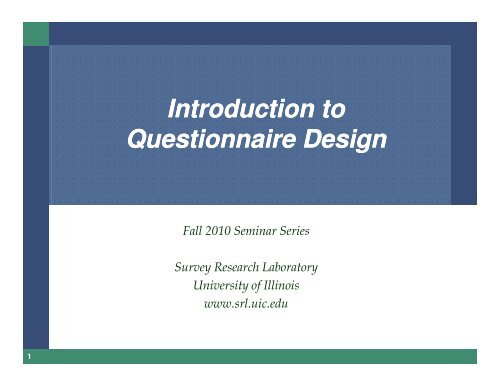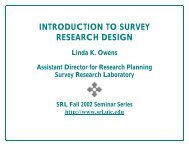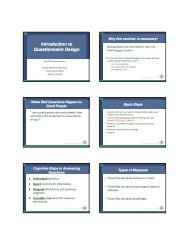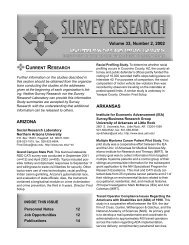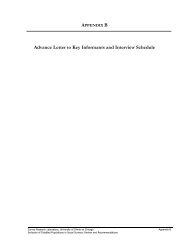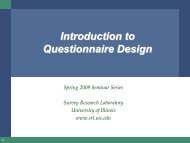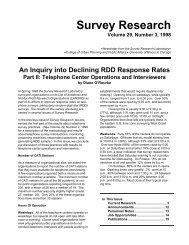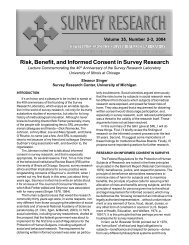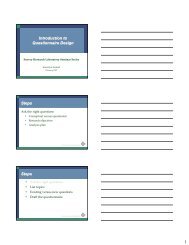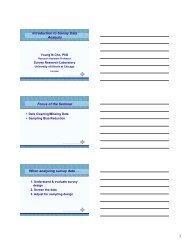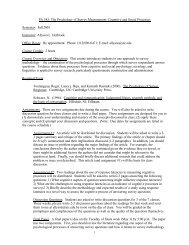Introduction to Questionnaire Design - Survey Research Laboratory
Introduction to Questionnaire Design - Survey Research Laboratory
Introduction to Questionnaire Design - Survey Research Laboratory
You also want an ePaper? Increase the reach of your titles
YUMPU automatically turns print PDFs into web optimized ePapers that Google loves.
<strong>Introduction</strong> <strong>to</strong><br />
<strong>Questionnaire</strong> <strong>Design</strong><br />
Fall 2010 Seminar Series<br />
<strong>Survey</strong> <strong>Research</strong> Labora<strong>to</strong>ry<br />
University of Illinois<br />
www.srl.uic.edu<br />
1
<strong>Questionnaire</strong> design encompasses<br />
1. Writing questions<br />
2. Organizing and formatting<br />
questionnaire<br />
<strong>Survey</strong> <strong>Research</strong> Labora<strong>to</strong>ry<br />
2
Open vs. Closed Questions<br />
• Open-Ended Questions<br />
• Suggest no alternatives<br />
• Probing<br />
• Extensive interviewer training<br />
• Elaborate coding schemes<br />
• Expensive and time-consuming<br />
• Free exchange of ideas without bias<br />
<strong>Survey</strong> <strong>Research</strong> Labora<strong>to</strong>ry<br />
3
Open vs. Closed Questions<br />
• Closed-Ended Questions<br />
Standardized questions and answers<br />
Simple interviewer training<br />
<br />
<br />
<br />
<br />
<br />
Easy <strong>to</strong> analyze<br />
May make it <strong>to</strong>o easy <strong>to</strong> answer without thinking<br />
May limit spontaneity<br />
Not best when<br />
• asking for frequency of sensitive behaviors<br />
• there are numerous possible responses<br />
Role of initial question development and pretesting<br />
<strong>Survey</strong> <strong>Research</strong> Labora<strong>to</strong>ry<br />
4
Cognitive Steps in Answering<br />
Questions<br />
1. Understand question.<br />
2. Search memory for information.<br />
3. Integrate information in<strong>to</strong> summary<br />
judgment.<br />
4. Translate judgment on<strong>to</strong> response<br />
alternatives.<br />
“Optimizing”<br />
<strong>Survey</strong> <strong>Research</strong> Labora<strong>to</strong>ry<br />
5
Cognitive Steps<br />
• Understand question.<br />
• Search memory for information.<br />
• Integrate information in<strong>to</strong> summary judgment.<br />
• Translate judgment on<strong>to</strong> response<br />
alternatives.<br />
“Weak satisficing”<br />
<strong>Survey</strong> <strong>Research</strong> Labora<strong>to</strong>ry<br />
6
Cognitive Steps<br />
• Understand question.<br />
• Search memory for information.<br />
• Integrate information in<strong>to</strong> summary<br />
judgment.<br />
• Translate judgment on<strong>to</strong> response<br />
alternatives.<br />
“Strong satisficing”<br />
<strong>Survey</strong> <strong>Research</strong> Labora<strong>to</strong>ry<br />
7
Fac<strong>to</strong>rs Influencing Satisficing<br />
• Respondent motivation<br />
• Respondent ability<br />
• Task difficulty<br />
<strong>Survey</strong> <strong>Research</strong> Labora<strong>to</strong>ry<br />
8
Response Effects Explained by<br />
Satisficing<br />
•Response order<br />
•Acquiescence<br />
•Non-differentiation<br />
•Saying “don’t know”<br />
<strong>Survey</strong> <strong>Research</strong> Labora<strong>to</strong>ry<br />
9
Response order effects<br />
•Primacy<br />
•Recency<br />
<strong>Survey</strong> <strong>Research</strong> Labora<strong>to</strong>ry<br />
10
Response Effects Explained by<br />
Satisficing<br />
•Response order<br />
•Acquiescence<br />
•Non-differentiation<br />
•Saying “don’t know”<br />
<strong>Survey</strong> <strong>Research</strong> Labora<strong>to</strong>ry<br />
11
Acquiescence<br />
Form A (agree I’s version):<br />
Individuals are more <strong>to</strong> blame<br />
than social conditions for<br />
crime and lawlessness in this<br />
country.<br />
Form A (Agree I’s)<br />
Agree (I): 59.6%<br />
Disagree (SC): 40.4<br />
100<br />
(473)<br />
Form B (agree SCs version):<br />
Social conditions are more <strong>to</strong><br />
blame than individuals for<br />
crime and lawlessness in<br />
this country.<br />
Form B (Agree SCs)<br />
Agree (SC): 56.8%<br />
Disagree (I): 43.2<br />
100<br />
(472)<br />
<strong>Survey</strong> <strong>Research</strong> Labora<strong>to</strong>ry<br />
12
Acquiescence<br />
I like going <strong>to</strong> the movies.<br />
Strongly Agree Neither Disagree Strongly<br />
agree<br />
disagree<br />
Do you like or dislike going <strong>to</strong> the movies?<br />
Like<br />
Dislike<br />
<strong>Survey</strong> <strong>Research</strong> Labora<strong>to</strong>ry<br />
13
Response Effects Explained by<br />
Satisficing<br />
•Response order<br />
•Acquiescence<br />
•Non-differentiation<br />
•Saying “don’t know<br />
<strong>Survey</strong> <strong>Research</strong> Labora<strong>to</strong>ry<br />
14
Non-differentiation<br />
How important is each of the following qualities for<br />
a child <strong>to</strong> have?<br />
Not<br />
important<br />
Extremely<br />
important<br />
Good manners 1 2 3 4 5 6 7<br />
Tries hard <strong>to</strong> succeed 1 2 3 4 5 6 7<br />
Is honest 1 2 3 4 5 6 7<br />
Is neat and clean 1 2 3 4 5 6 7<br />
Has sound judgment 1 2 3 4 5 6 7<br />
<strong>Survey</strong> <strong>Research</strong> Labora<strong>to</strong>ry<br />
15
Response Effects Explained by<br />
Satisficing<br />
•Response order<br />
•Acquiescence<br />
•Non-differentiation<br />
•Saying “don’t know<br />
<strong>Survey</strong> <strong>Research</strong> Labora<strong>to</strong>ry<br />
16
Other Issues<br />
• Double-barreled questions<br />
Question:<br />
Compared <strong>to</strong> one year ago,<br />
are you paying more, less, or<br />
about the same for your au<strong>to</strong><br />
and life insurance?<br />
Better Question:<br />
Compared <strong>to</strong> one year ago, are<br />
you now paying more, less, or<br />
about the same for…<br />
a. au<strong>to</strong> insurance?<br />
b. life insurance?<br />
<strong>Survey</strong> <strong>Research</strong> Labora<strong>to</strong>ry<br />
17
Other Issues<br />
• Specify who, what, when, where and<br />
how<br />
Question:<br />
What is your <strong>to</strong>tal household<br />
income?<br />
Better Question:<br />
In 2002, what was your <strong>to</strong>tal<br />
household income, before taxes?<br />
Please count income from all<br />
members of your household,<br />
including wages from<br />
employment, disability, social<br />
security, and public aid<br />
<strong>Survey</strong> <strong>Research</strong> Labora<strong>to</strong>ry<br />
18
Other Issues<br />
• Specify through cues<br />
Question:<br />
During the past 30 days, did<br />
you drink any beer?<br />
Better Question:<br />
People drink beer in many places<br />
– for example, at home, at<br />
restaurants, at bars, sporting<br />
events, at friends’ homes, etc.<br />
During the past 30 days, did you<br />
drink any beer?<br />
<strong>Survey</strong> <strong>Research</strong> Labora<strong>to</strong>ry<br />
19
Other Issues<br />
Use words with singular meanings<br />
Ambiguous:<br />
How would you compare<br />
how close you are <strong>to</strong> family<br />
in your current neighborhood<br />
<strong>to</strong> how close you were in<br />
your old neighborhood?<br />
Would you say your family is<br />
closer here, further here, or<br />
the same?<br />
Clearer:<br />
Compared <strong>to</strong> your last<br />
neighborhood, do you now<br />
live closer <strong>to</strong> your family,<br />
are you further from your<br />
family, or are you about<br />
the same distance?<br />
<strong>Survey</strong> <strong>Research</strong> Labora<strong>to</strong>ry<br />
20
Other Issues<br />
• Response Options<br />
Should be consistent with the question<br />
Should typically be exhaustive, including<br />
every possible answer<br />
Categories should typically be mutually<br />
exclusive (no overlap)<br />
<strong>Survey</strong> <strong>Research</strong> Labora<strong>to</strong>ry<br />
21
Other Issues<br />
• Numbering vs. Labeling<br />
Numbers alone<br />
Partial labeling<br />
Full labeling<br />
<strong>Survey</strong> <strong>Research</strong> Labora<strong>to</strong>ry<br />
22
Other Issues<br />
• Constructing Response Scales<br />
Length of response scale<br />
Using graphic images, such as<br />
thermometers and ladders, and card<br />
sorting for complex ratings<br />
<strong>Survey</strong> <strong>Research</strong> Labora<strong>to</strong>ry<br />
23
Physical Format Checklist<br />
Number all questions sequentially<br />
Use large, clear type; don’t crowd<br />
‘White space:’ Place more blank space between<br />
questions than between subcomponents of questions<br />
List answer categories vertically instead of<br />
horizontally<br />
Avoid double/triple ‘banking’ of response choices<br />
Be consistent with direction of response categories<br />
<strong>Survey</strong> <strong>Research</strong> Labora<strong>to</strong>ry<br />
24
Physical Format Checklist (continued)<br />
Don’t split questions across pages. If necessary (e.g.,<br />
question requires 1.5 pages), restate question and<br />
response categories on next page<br />
Put special instructions on questionnaire as needed,<br />
next <strong>to</strong> question<br />
<br />
Distinguish directions from questions – be consistent<br />
<strong>Survey</strong> <strong>Research</strong> Labora<strong>to</strong>ry<br />
25
Key References To Get Started<br />
Dillman, Don. Mail and Internet <strong>Survey</strong>s: The Tailored<br />
<strong>Design</strong> Method. New York: John, Wiley & Sons, Inc,<br />
1999.<br />
Bradburn, N, Sudman, S. and Wansink, B. Asking<br />
Questions: The Definitive Guide <strong>to</strong> <strong>Questionnaire</strong><br />
design – for Market <strong>Research</strong>, Political Polls, and Social<br />
and Health <strong>Questionnaire</strong>s. San Francisco: Jossey Bass,<br />
2004.<br />
See also past issues of Public Opinion Quarterly<br />
<strong>Survey</strong> <strong>Research</strong> Labora<strong>to</strong>ry<br />
26
Other References<br />
Schuman, H., & Presser, S. (1981). Questions and answers<br />
in attitude surveys. New York: Academic Press.<br />
Krosnick, J.A. (1991). Response strategies for coping with<br />
the cognitive demands of attitude measures in surveys.<br />
Applied Cognitive Psychology, 5, 213-236.<br />
Krosnick, J.A., Holbrook, A. L., Berent, M. K., Carson, R.<br />
T., Hanemann, W. M., Kopp, R. J., Mitchell, R. C., et al.<br />
(2002). The impact of "No Opinion" response options<br />
on data quality: Non-attitude reduction or an invitation<br />
<strong>to</strong> satisfice? Public Opinion Quarterly, 66, 371–403.<br />
<strong>Survey</strong> <strong>Research</strong> Labora<strong>to</strong>ry<br />
27
<strong>Survey</strong> Intro/Cover Letter<br />
<strong>Introduction</strong> should indicate:<br />
who is conducting the survey<br />
the <strong>to</strong>pics <strong>to</strong> be covered in the survey<br />
an assurance of confidentiality<br />
any IRB stipulations<br />
whether you offer how long it will take<br />
depends on mode, <strong>to</strong>pic, population<br />
<strong>Survey</strong> <strong>Research</strong> Labora<strong>to</strong>ry<br />
28
Ordering the Questions<br />
Put demographic questions at the end<br />
Leave objectionable questions (e.g., income) for<br />
the end<br />
First questions should be directly related <strong>to</strong> the<br />
<strong>to</strong>pic as described in the introduction or<br />
advance/cover letter<br />
<strong>Survey</strong> <strong>Research</strong> Labora<strong>to</strong>ry<br />
29


